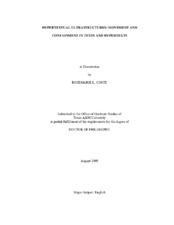| dc.description.abstract | The surface-level experience of hypertextuality as formless and unbounded, blurring boundaries among texts and between readers and writers, is created by a deep structure which is not normally presented to readers and which, like the ultrastructure of living cells, defines and controls texts' nature and functions. Most readers, restricted to surface-level interaction with texts, have little access to the deep structure of any hypertext. In this dissertation, I argue that digital hypertexts differ essentially from paper texts in that hypertexts are constructed in multiple layers, with surface-level appearance and behavior controlled by sub-surface ultrastructure, and that these multiple layers of structure enable and necessitate new methods of textual study designed for digital texts.
Using participant-observation from within my own practice as a webmaster, I closely examine the sub-surface structural layers that create several kinds of Web-based digital hypertexts: blogs, forums, static Web pages, and dynamic Web pages. With these hypertexts as the primary models, along with their enabling software and additional digital texts-wikis, news aggregators, word processing documents, digital photographs, electronic mail, electronic forms-available to me as a reader/author rather than a webmaster, I demonstrate methods of investigating and describing the development of digital texts. These methods, like methods already established within textual studies to trace the development of printed texts, can answer questions about accidental and intentional textual change, the roles of collaborators, and the ways texts are shaped by production processes and mediating technologies. As a step toward a formalist criticism of hypertext, I propose concrete ways of categorizing, describing, and comparing hypertexts and their components. I also demonstrate techniques for visualizing the structures, histories, and interrelationships of hypertexts and explore methods of using self-descriptive surface elements in paper-like texts as partial substitutes for the sub-surface self-description available in software-like texts. By identifying digitization as a gateway to cooperation between human and artificial intelligences rather than an end in itself, I suggest natural areas of expansion for the humanities computing collaboration as well as new methodologies by which originally-printed texts can be studied in their digital forms alongside originally-digital texts. | en |


